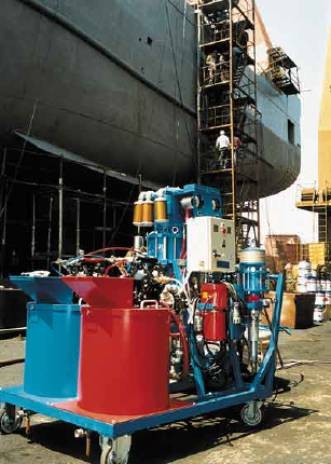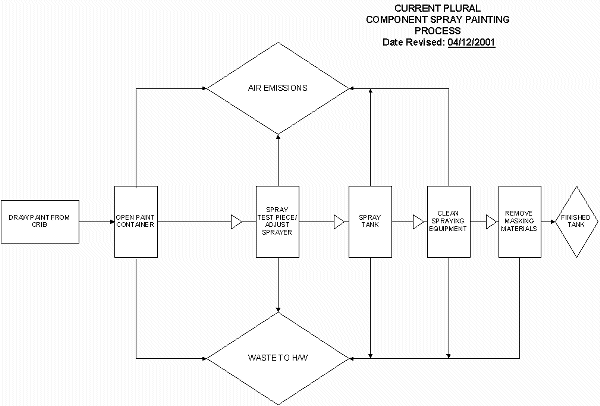| Overview: |
Plural component painting systems were evaluated during the 1990's and have been listed in the Navy P2 Equipment Book since May 1997. The original assessments identified the environmental and economic benefits associated with using these systems, as well as the compatibility of the equipment with ship and shore
operations. P2 Opportunity Handbook Datasheet: Plural Component Proportioning System for Epoxy Paints, offers an in-depth discussion of this
technology. However, special considerations with respect to submarine material and maintenance procedures were not evaluated in
the initial assessments. Special aspects that must be considered when new equipment is being evaluated for this kind of specialized
work include: atmospheric controls, confined and limited space, unique hull shape, submerged submarine hull integrity safety (SUBSAFE)
requirements, and safety factors. Because these special considerations were not evaluated in the initial studies the Submarine
Maintenance, Engineering, Planning and Procurement Activity (SUBMEPP) entered into a Memorandum of Agreement (MOA) with Portsmouth
Naval Shipyard (PNS) and Naval Sea Systems Command (NAVSEA) Code 92T to evaluate P2 plural component painting systems. The
objectives of the study were to: 1) evaluate the environmental and economic benefits of using plural component painting units for
submarine material and maintenance work; 2) compare them to the single component units in use at the time of the study; and 3) determine
if submarine shore facilities could integrate plural component painting units into their operations. The results of this
study, P2 Equipment Evaluation of Plural Component Painting, completed in March 2002, are summarized in this Datasheet.
The following recommendations were made as a result of this study:
- Establish plural component paint spraying of Main Ballast Tanks (MBTs) as a Best Management Practice (BMP) for Submarines for depot-level maintenance.
- Update UIPI 6311-460 ("Seawater Tanks, Preservation of") to reflect the use of plural component painting equipment.
- Consider centrally procuring six plural component paint units for each shipyard that services submarines.
- Study the potential use of plural component painting at Ships Intermediate Maintenance Activities (SIMA) and other intermediate maintenance activities.
|
| Compliance Benefit: |
None are indicated in the SUBMEPP Report. For additional information, see the Compliance Benefit section of the P2 Opportunity Handbook Datasheet: Plural Component Proportioning System for Epoxy Paints.
The compliance benefits listed here are
only meant to be used as general guidelines and are not meant to be strictly
interpreted. Actual compliance benefits will vary depending on the factors
involved, e.g., the amount of workload involved.
|
| Materials Compatibility: |
None are indicated in the SUBMEPP Report. For additional information, see the Material Compatibility section of the P2 Opportunity Handbook Datasheet: Plural Component Proportioning System for Epoxy Paints.
|
| Safety
and Health: |
Health concerns depend on
the variety of paint that is used. The use of polyurethane paints requires
implementation of precautions associated with isocyanates. Inhalation of
lead- and zinc chromate-based paints can lead to irritation of the respiratory
system. Some lead compounds are carcinogenic. Solvent-based paints can irritate
the lungs and mucous membranes. Prolonged exposure can affect respiration
and the central nervous system. Proper personal protective (PPE) equipment
should be used. These safety and health issues are also applicable when
using conventional methods.
Consult your local industrial health specialist,
your local health and safety personnel, and the appropriate MSDS prior
to implementing this technology.
|
| Benefits:
|
- The amount of labor required to paint the MBTs decreased approximately 40 percent because paint-mixing personnel were not needed when plural component units were used.
- The amount of paint waste decreased by 87 percent because the need for premixing the paint was eliminated. This decrease was realized even though the amount of paint needed for both kinds of painting units was basically the same.
- Plural component proportioning systems are effective for many two-component
paint systems besides epoxy paints, such as polyurethane paints.
- The total amount of hazardous waste decreased by 12 percent.
- The paint quality and thickness were not adversely affected by using the plural component spray unit.
- The ability to position the equipment under the hull after the submarine is placed into the drydock is a key factor. This allows the workers who operate the pumps to closely communication with the painters. Plural component painting units equipped with wheels are important for painting submarines in graving drydocks.
|
| Disadvantages:
|
- The amount of solvent used increased by 368 percent.
- The amount of solvent waste increased by 86 percent.
- The paint-out time for the entire job increased by approximately 3 percent.
Note: The SUBMEPP Report evaluators thought that solvent use was high and that the paint-out time was extended because only two plural component painting units were used during the study. The use of two units meant that equipment cleanup and restart was required each time the paint color was changed. Since six paint changes are required during each MBT job, these paint color changes account for a significant amount of solvent use and paint-out time. The PNS evaluators suggested that a total of six plural component painting units be used for each MBT job. Three plural component painting units would be used in the bow area to service the forward tanks, and three plural component painting units would be used in the stern area to service the aft tanks. In each area one unit would be used for each of the three required paint colors: primer, stripe and topcoat. The use of six painting units would allow for a continuous paint supply during each MBT job without the need for cleanup and restart for each paint color change.
- Some types of spray guns require more maintenance and frequent change-out of seals, which results in downtime during the painting operation. It is important to use the most appropriate spray gun for the type of paint applied.
- Attachments for pumping paint from 55-gallon drums are superfluous for submarine work. The additional $20,000 cost negates the need for them on MBT work on submarines.
- Equipment provided by foreign companies may have electrical requirements different from those in the United States. These differences could require modifying the units in order to meet local utility needs.
|
|
Economic
Analysis: |
Initial investment costs:
- Purchase of 2 Plural Component Painting units @ $65,000 each = $130,000.
- Initial Training: 15 hours for 10 people @ $75 per hour = $11,250.
Assumptions:
- The cost of personal protective equipment is the same for both single and plural component spraying.
- The cost of air and electricity is the same for both single and plural component spraying.
- The estimated annual workload for a Naval Shipyard is two paintings of a 688-Class submarine MBT system (10 tanks each).
- Inflation is 3 percent per year.
- Useful equipment life is 10 years.
- Only two plural component painting units are purchased.
Note: An Economic Analysis for the purchase of six plural component painting units is also available.
Annual Operating Cost Comparison for Plural Component
Painting versus Single Component Painting for Submarine Main Ballast Tank Maintenance
| |
|
|
|
Annual Operating Costs:
|
|
|
|
Paint
|
$98,402
|
$94,662
|
|
Solvent
|
$1,556
|
-
|
|
Spray Lines
|
$6,000
|
-
|
|
Spray Gun Tips
|
$1,200
|
-
|
|
Maintenance Parts
|
$3,000
|
$400
|
|
Hazardous Waste Disposal
|
$2,110
|
$1,854
|
|
Operating Labor
|
$135,000
|
$81,000
|
|
Cleanup Labor
|
$1,800
|
$1,800
|
|
HW Management
|
$16
|
$50
|
|
Equipment Maintenance
|
$1,500
|
$150
|
Economic Analysis Summary
- Net Present Value :$175,695 for 10 years
- Internal Rate of Return: 35.9% for 10 years
- Discounted Payback: 3.58 years
Click Here to View an Active Spreadsheet for this Economic
Analysis and Enter Your Own Values. To return from the Active Spreadsheet,
click the Back arrow on the Tool Bar.
|
| NSN/MSDS:
|
None identified
|
| Approving
Authority: |
Appropriate authority for
making process changes should always be sought and obtained prior to procuring or
implementing any of the technology identified herein.
|
| Points of Contact: |
For more information
|
| Vendors: |
This is not meant to be a complete list, as there may be other manufacturers of this type of equipment.
WIWA GmbH & Co KG
POB 29
D-35631 Lahnau
Germany
Phone: +49 64 41 6 09 0
Fax: +49 64 41 6 09 50/58
Email: info@wiwa.de
URL: http://www.wiwa.de/
Graco
P.O. Box 1441
Minneapolis, MN 55140
Phone: 877-844-7226
|
| Related Links: |
Plural Component Proportioning System for Epoxy Paints - P2 Opportunity Handbook Datasheet
Do You Use Two Part Epoxy Paint? - Navy Environmental Quality Initiative (EQI)
Plural Component Paint System - P2 Equipment Book
Plural Component High and Ultra High Solids Paint Systems - P2 Equipment Book
|
| Sources:
|
P2 Equipment Evaluation of Plural Component Painting, Submarine Maintenance, Engineering,
Planning and Procurement Activity in cooperation with Portsmouth Naval Shipyard
|
| Supplemental: |
Plural Component Painting of a Ship

Current Plural Component Spray Painting Process

|


